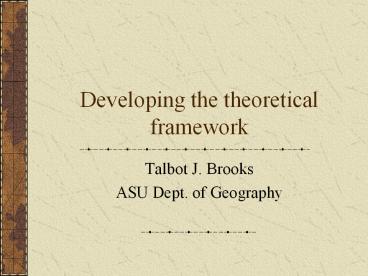Developing the theoretical framework - PowerPoint PPT Presentation
1 / 17
Title:
Developing the theoretical framework
Description:
Prepare in a visual format and support with additional documentation ... symbolization of entities (especially positional accuracy of symbol due either ... – PowerPoint PPT presentation
Number of Views:163
Avg rating:3.0/5.0
Title: Developing the theoretical framework
1
Developing the theoretical framework
- Talbot J. Brooks
- ASU Dept. of Geography
2
GIS Development Cycle
- Needs Assessment
- Creation of an implementation plan
- Develop a theoretical framework
- Survey of Available Data
- Survey of GIS Hardware and Software
- Detailed Database Planning and Design
- Database Construction
- Pilot Study/Benchmark Test
- Review/modify the original plan
- Acquisition of GIS Hardware and Software
- GIS System Integration
- GIS Application Development
- GIS Use and Maintenance
3
(No Transcript)
4
(No Transcript)
5
Developing the theoretical framework
- is based upon the output of products from the
needs assessment - Application description
- Functions to be used
- Master data list
- Data flow diagram
- Prepare in a visual format and support with
additional documentation
6
Developing the theoretical framework Focusing on
Database Design
- Conceptual data modeling identify data content
and describe data at an abstract, or conceptual,
level. This step is intended to describe what
the GIS must do and does not deal with how the
GIS will be implemented - the "how" question is
the subject of logical and physical database
design
7
Developing the theoretical framework Focusing on
Database Design
- Logical database design translation of the
conceptual database model into the data model of
a specific software system and - Physical database design representation of the
logical data model in the schema of the software.
8
Understand the nature of spatial data
9
Conceptualize the data process
10
(No Transcript)
11
Sketch out your data model in a simple E-R diagram
12
Break out major components and specialize to fit
GIS
13
(No Transcript)
14
(No Transcript)
15
Start fleshing thing out
16
(No Transcript)
17
Summary
- 1) Each entity and its attributes map into
- One or more relational tables with appropriate
primary and secondary keys (this assumes the
desired level of normalization has been
obtained) - The corresponding spatial entity for the
"regular" entity. As most commercial GISs rely
on fixed structures for the representation of
geometric coordinates and topology, this step is
simply reduced to ensuring that each
corresponding spatial entity can be handled by
the selected GIS package - 2) Each relationship into
- Regular relationships (diamond) executed by the
relational database system's normal query
structure. Again, appropriate keys and
normalization are required for this mapping. - Spatial relationships implemented through spatial
operations in the GIS. The functionality of each
spatial relationship needs to be described, and
if not a standard operation of the selected GIS,
specifications for the indicated operation need
to be written.































